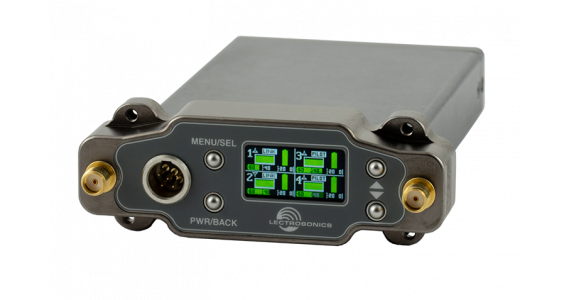Four Channel Digital Slot Receiver
Model: DSR4-A1B1, DSR4-B1C1, DSR4-941, DSR4-961
- Two diversity options for maximum flexibility
- 24 bit/48 kHz digital for flawless audio
- AES 256-bit, CTR mode encryption, with 4 different key policies available
- High IP3 performance of +15 dBm for tough RF environments
- Analog and AES3 digital audio outputs
- External DC powering options and USB input for firmware updates (Wireless Designer pending) and data transfer
- Full integration with Sound Devices 8-Series mixer/recorders with v1.09 firmware and 8-Series v9.30
The DSR4 digital receiver provides the highest level of RF and audio performance available with a versatile feature set in a compact design for field and location production. Settings can be made from the front panel with tactile buttons and color LCD interface, making the unit ideal for use in portable bag systems and on sound carts. An RF spectrum analyzer and SmartTune are built into the receiver to alleviate interference problems in an increasingly congested RF spectrum.
The mechanical design of the receiver fits into the Super-Slot ecosystem and combines field-proven features developed over many years of experience in motion picture and television production. To decrease weight, the DSR4 provides a four channel receiver in one unit powered by external DC. The receiver is also equipped with an IR port for data transfer between units. The machined aluminum housing and panels are surfaced with a hardanodized finish with laser etched markings to withstand the rigors of field production.
The RF gain stages in the front end use a newly developed design to provide low noise RF amplification, excellent sensitivity and extremely low susceptibility to intermodulation and de-sensitization.
5 Short “deep dive” videos on key features and functions in the DSR4 receiver
Features, capabilities, and how-tos in these videos include independent tuning ranges and compat modes, RF spectrum scanning, manual tuning, Smarttune auto frequency selection, and tuning groups with names and compat modes, known as “Party Dialing.”
